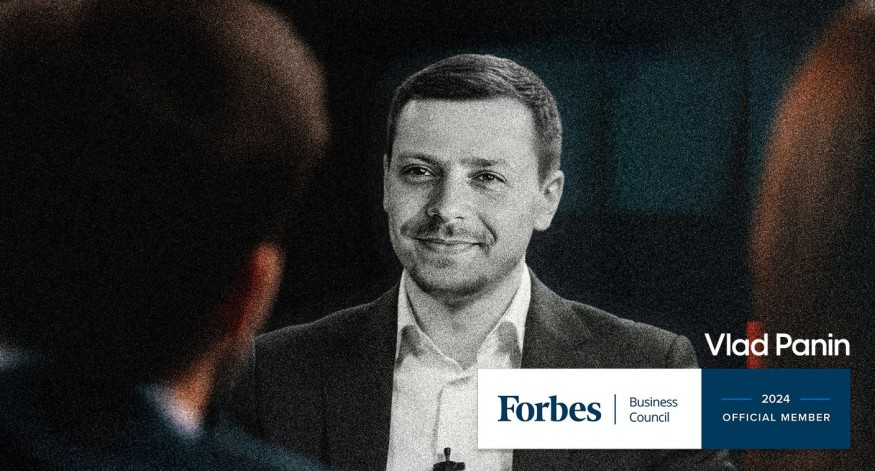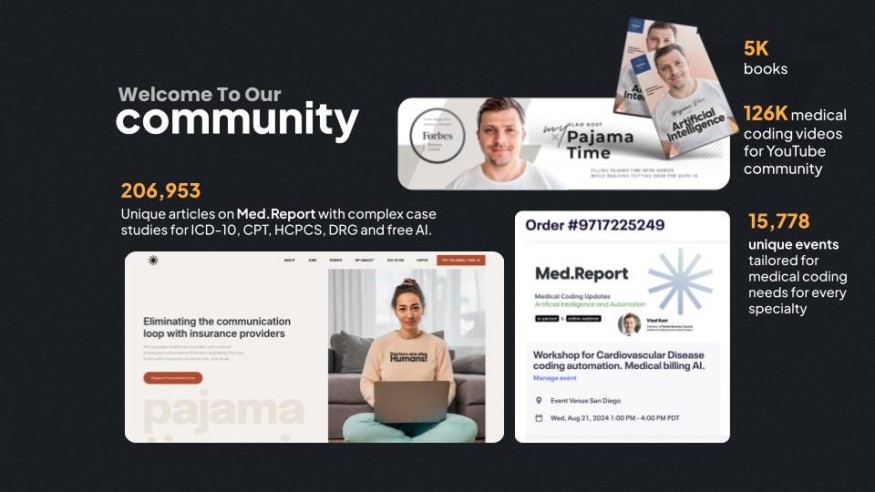
He is not a household name like Altman or Bezos. His face isn't known to millions. Yet, during his remarkable 16-year career, a few have done more than Vlad Panin to understand the digital side of healthcare administration struggles and change how we manage our healthcare records.
He co-authored the Large Language Models curriculum for Ph.D. students recommended by the Ministry of Education and, most importantly, invented a first-of-a-kind Large Medical Revenue Cycle Management AI model, dramatically improving the healthcare experience for millions of Americans.
This non-typical entrepreneur has the gift of envisioning the future and, over the past decade, has actively engineered transformative healthcare systems that have already impacted over 45 million users.
This feature isn't about flashy pronouncements or theoretical concepts. Vlad's approach is marked by a healthy dose of realism. Panin recognizes that for adopting transformative technologies, especially in a field as sensitive as healthcare, innovation, patience, and education are critical. Yet, the key is a clear demonstration of benefits to the end-users.
This article brings his journey and visionary ideas to the fore.
Idea #1
2008 – The computing consolidation approach is inevitable.
In 2008, Vlad Panin created a custom database management system, The Orkin, capable of handling high-frequency read/write request volumes, a necessity for sophisticated web applications. This innovation positioned his company as one of the first cloud-hosting vendors in Eastern Europe, proving instrumental in the advent of the cloud era.
"Transitioning databases to the cloud was crucial for enhancing scalability and flexibility," says Panin. "It was the inevitable step toward optimizing resource utilization and reducing IT costs."
It is worth mentioning that by showcasing his high-tech invention, Vlad grew his hobby business, e-commerce called StarMusic, from an empty flat web catalog to a tier 1 international musical instruments store with its electric guitar manufacturer—Panin Guitars.
"Many would say that launching the entire e-commerce business to showcase the product signals a lack of focus. I agree. Yet, for me, it was a personal challenge proving that flat catalogs are dead, and everyone has to think about marketplaces as stand-alone products themselves," says Panin. "It turns out our clients were not in e-commerce but in the media and entertainment sector, yet I still think we wouldn't have these clients without a bold proof of concept."
Idea #2
2010 – The silent war between Apple and Android apps' ecosystems will be won by Web Browsers.
The growth of Apple and Android apps' ecosystems in the early 2010s drove Vlad to see the potential in technologies such as WebSockets, WebRTC, and REST APIs for cross-platform data exchange.
His ventures' journey brought him to the creation of The Atlant, a community app built using HTML, CSS, and JS only, which facilitated secure real-time communication without native app coding.
While thousands of users have downloaded the application from the App Store and Play Market in days, Vlad decided to go against the mainstream and double down on web browser native technologies.
This foresight proved invaluable during the COVID-19 pandemic when community support became critical. While every update on the App Store and Play Market took weeks or even months, the circumstances demanded instant improvements, which were possible only because of the company's strategic decisions years ahead.

"I always stayed away from monopolies' marketplaces. Our task was facilitating seamless data exchange without trading security," he notes. "It's critical to understand that in 2010, both IOS and Android did a lot of experiments with security; Products had no choice but to adopt whatever came from the top. We choose freedom, and I'm glad we made it right from the very beginning."
Idea #3
2012 – Healthcare Administration can't be simplified, yet it could be automated.
Years of Panin's work with the United Nations were transformative for millions. He spearheaded eHealth projects called Electronic Healthcare Records Systems that connected thousands of healthcare providers and pharmacies, servicing over 45 million people daily. When the project officially launched in 2014, it unlocked the unimaginable cross-connection of medical records, enabling medical professionals in Europe to assess the full picture of patients' use cases instantly, skipping redundant data consolidation processes.
"I'm so glad to watch over The US Sequoia Project's success with updates in the Trusted Exchange Framework and Common Agreement. That might hurt monopolies purposely locking data inside their systems. Yet, benefits for US healthcare providers and patients will be enormous." explains Panin.
Idea #4
2014 – Web 2.0 evolvement requires legislation 2.0 shaped for online transactions.
It was obvious that Web 2.0 had already created a platform for the supply of remote services, which initiated the demand for people's decision certification in the digital world.
After launching multiple eHealth and Smart City projects backed by the United Nations, Vlad became laser-focused on cyber security. This resulted in extensive research during his PhD program, including comprehensive work on electronic and digital signatures regulations.
"Putting AI aside, simple WebRTC-based telehealth services have been a commodity for a decade. Yet visiting a hospital to sign forms to access patients' data and handle prior authorization is absurd," Panin emphasizes. "Proper certification of all actions with electronic healthcare records is indispensable for managing prior authorization and other critical healthcare workflows. Nobody talks about the US dependency on foreign labor for medical coding. A recent case with UnitedHealth Group, when, according to Reuters, every third of US patient data was exposed to hackers, proves that it is the US's largest leaky bucket of personal data ever. I hope key players (meaning large corporations) will be smart enough to change."
Idea #5
2022 – Exploiting cheap foreign labor has tradeoffs and must be fixed.
According to recent data, most healthcare organizations experience claim denial rates between 5% and 15%, representing hundreds of thousands, if not millions, of dollars in unrecovered revenue. Openpractice.net claims that healthcare centers lose almost 15 cents per dollar due to inefficient revenue cycles.
The situation has worsened over time. Change Healthcare reported a 23% increase in claim denials from 2016 to 2022, with the rate rising from 9% to more than 11.1%.
"I suspect there is a direct connection between medical coding outsourcing to foreign countries and so-called cybersecurity attacks on healthcare software," Vlad suggests.
Nonetheless, due to Vlad's recent book "Pajama Time: Or How AI Will Change Healthcare Administration," this trend is likely to continue, putting additional pressure on healthcare providers. Coding errors are a major contributor to these inefficiencies. Approximately 37% of denials are attributed to incorrect coding. This aligns with reports that up to 90% of denials are preventable and often result from errors in claims submission or inadequate documentation.
To complete the picture, here are some numbers from Vlad's book: Bellmadex highlights that around 80% of medical bills contain errors, and the cost of reworking denied claims ranges from $25 to $118 per claim. Hanseisolutions.com claims that coding errors cost the healthcare industry more than $20 billion, with error rates as high as 40%.
"Large Medical Revenue Circle Models like iFrameAI can handle claim processing in seconds, compared to 5 minutes to 24 hours traditionally, dramatically improving operational efficiency and security, since data never leaves the cloud in local State," says Panin.
His recent book predicts that large medical revenue circle models will replace nonsecure outsourced medical note processing by 2025.
Idea #6
2024 – Demonopolization of Healthcare in the US is inevitable.
The US healthcare market is known for large monopolies. Panin thinks this is one of the critical reasons for the disturbing trends we highlighted in this article.
Current Procedural Terminology (CPT) is an excellent example of how one commercial organization, the American Medical Association, makes hundreds of millions in royalties for the required usage of a one-of-a-kind, non-alternative library of Procedural Terminology.
Clearinghouses are legally obligated to pay AMA whatever this company is willing to ask. Otherwise, they'll be unable to complete reimbursement claims even for government-funded programs.
"It seems that not the US (government), but the AMA controls the speed of redundancy reduction in revenue cycle management ... with the current business model—charging every employee for using CPT codes, any AI automation will lead to an instant loss of revenue for AMA," said Vlad.
"Because of such a power held by undisputable monopolies like UnitedHealth Group, it is just a matter of time before their medical coding outsourcing approach will paralyze the entire industry. The horrible part is that nobody would talk about that because affected doctors have to pass a credentialing process completely controlled by these monopolies. Regulators have to step in before a real disaster happens."
Meanwhile, the Vlad Panin Foundation established the world's largest revenue circle management community—Med.Report. RCM managers have access to thousands of free webinars yearly, over two hundred thousand practical use cases for proper medical coding, an RCM jobs marketplace, and comprehensive media materials to improve revenue circle management (RCM) practices.

In 2022, Vlad's company, Meacado Inc., invented the first medical coding AI in the World based on a unique mixture of experts' architecture. Its name is iFrameAI, and the model was trained on an in-house-created The High Precision Universal Medical Automation Coding System (HP UMACS™) that sets new standards for accuracy in medical coding, with a direct impact reflected in business metrics.
"While HP UMACS™ is unusable by humans due to high precision that comes with large library size tradeoff, it's unmatched accuracy in clinical documentation improvement (CDI) and AI readiness directly influencing healthcare providers' revenue integrity," Panin elaborates. "The US healthcare market democratization is inevitable, and our open source HP UMACS™ designed to drive such positive changes."
What's next?
Panin's recent venture, iFrameAI, has already secured institutional VC funds and strategic partnerships with leading universities and healthcare networks. Combined with unique support for The US startups provided by Google, Microsoft, and AWS, iFrameAI was capable of training a unique Large Medical Revenue Circle Model with a 10M context window, 100% medical coding accuracy, and native integration with the most popular electronic healthcare systems.
These advances have fueled The Med.Report's thousands of user registrations in weeks and critical pilots with major U.S. healthcare networks.

"Our mission is to replace RCM redundancy with innovative solutions, yet we should be very grounded with our vision and approaches. To make it work, we have to focus on practical applications in the field that bring proven benefits, not just fancy labels," Panin concludes.
Beyond tomorrow:
There are people like Vlad, whose capacity to pinpoint pivotal moments to challenge conventional norms and pioneer new technologies is remarkable. Interestingly, Vlad is an admirer of David Yang, co-founder of ABBYY, who is currently focused on developing autonomous digital workers.
Vlad committed $200,000 of his own savings to initiate new product development and attract additional backing from a Silicon Valley accelerator for his latest venture, IFORELS Inc.—a firm that constructs fully autonomous digital workers using the IF-OR-FOR-ELSE paradigm, allowing interaction with various AI models as though they were real assistants. These digital assistants are capable of performing the same tasks as today's office employees.
Vlad highlighted, "I'm a big fan of what David (Yang) is doing to popularize autonomous digital employees' ideas. The hope is that our dedication and support from top Silicon Valley funds will enable synergy with his philosophy and contribute to healthy competition in the field that redefines today's world economy."
Silicon Valley is indeed The Place where new ideas can be born and grow. Unique people are what help create new-age technologies that change how we live and work.
Vlad Panin is not just predicting the future of automation; he's actively constructing it, one innovation at a time. His journey offers a compelling roadmap for a future where technology ultimately improves healthcare quality for everyone while acknowledging the need for a realistic and measured approach to adoption and implementation.
© 2025 ScienceTimes.com All rights reserved. Do not reproduce without permission. The window to the world of Science Times.












